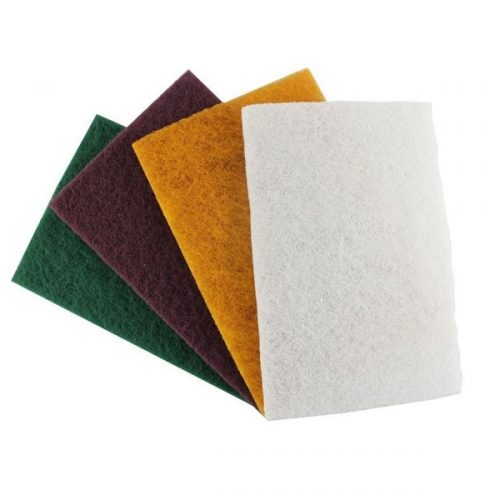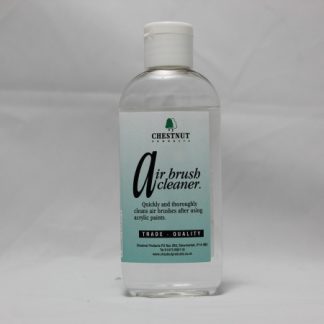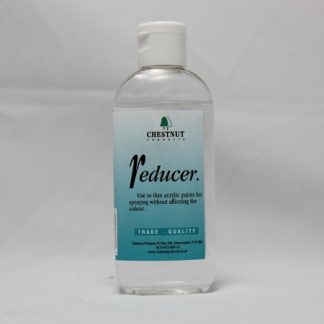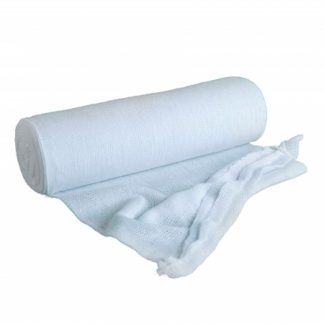-
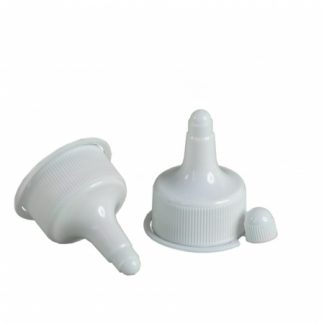 These Dispensing Nozzles are, in fact, almost indispensable! They fit onto any of Chestnuts' plastic bottles in the 250ml, 500ml and 1 ltr sizes, simply replacing the existing cap. Cut the tip off to the size you want and use the handy cover to reseal them when not in use. A useful by product of using these is that if you knock a bottle over the amount you lose through the small nozzle will be much less than without it. Just don’t forget to take the nozzle off the bottle before you throw it away so that you can re-use it! These nozzles are not child resistant, the correct closure should be replaced when the product is not in use.
These Dispensing Nozzles are, in fact, almost indispensable! They fit onto any of Chestnuts' plastic bottles in the 250ml, 500ml and 1 ltr sizes, simply replacing the existing cap. Cut the tip off to the size you want and use the handy cover to reseal them when not in use. A useful by product of using these is that if you knock a bottle over the amount you lose through the small nozzle will be much less than without it. Just don’t forget to take the nozzle off the bottle before you throw it away so that you can re-use it! These nozzles are not child resistant, the correct closure should be replaced when the product is not in use. -
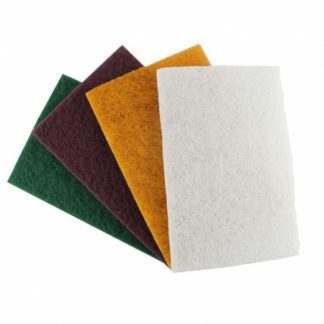 NyWeb pads are a non-woven nylon webbing with an abrasive – either silicon carbide or aluminium oxide – embedded into them to give an exactly defined cut.
NyWeb pads are a non-woven nylon webbing with an abrasive – either silicon carbide or aluminium oxide – embedded into them to give an exactly defined cut.- The Green pads are 400 grit
- The Red pads are 600 grit
- The Orange pads are 1000 grit
- The White pads do not contain an abrasive and are thus technically non-abrasive, but the very texture of the pads gives them an incredibly fine – but immeasurable – cut.
-
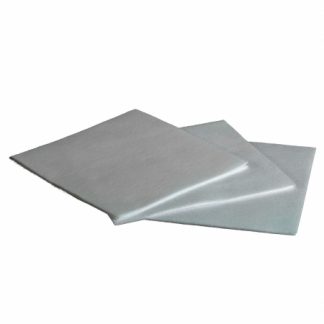 Safety Cloth is a thick, non-woven paper cloth. Designed to stay wet longer to assist the transfer of finishes to your chosen surface, it also tears very easily if it gets caught in revolving parts thus avoiding the danger of fingers being dragged into machinery. The texture of Safety Cloth ensures that a thin, even coat is applied and the thickness means that it retains it’s strength and the same piece can be used several times with the same finish. Safety Cloth is not a replacement for common sense and good safety practise.
Safety Cloth is a thick, non-woven paper cloth. Designed to stay wet longer to assist the transfer of finishes to your chosen surface, it also tears very easily if it gets caught in revolving parts thus avoiding the danger of fingers being dragged into machinery. The texture of Safety Cloth ensures that a thin, even coat is applied and the thickness means that it retains it’s strength and the same piece can be used several times with the same finish. Safety Cloth is not a replacement for common sense and good safety practise. -
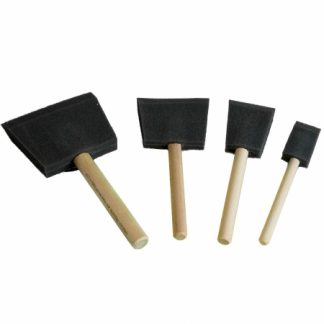 Made in the USA, these are the original and best quality Foam Brush. Manufactured using a special foam with a stiffener inside to make sure they keep their shape in use, and supplied with a solid wooden handle attached. Great for eliminating brush marks (no bristles = no brush marks) and there’s no danger of any stray bristles coming loose and spoiling your work. Priced to be semi-disposable they will normally wash out several times for re-use. Fantastic for applying acrylic finishes which have a tendency to froth up when applied by brush – the Foam Brush virtually eliminates this completely. Can also be used for painting, particularly gloss paints, seasoned users have been known to have a brush in each hand!
Made in the USA, these are the original and best quality Foam Brush. Manufactured using a special foam with a stiffener inside to make sure they keep their shape in use, and supplied with a solid wooden handle attached. Great for eliminating brush marks (no bristles = no brush marks) and there’s no danger of any stray bristles coming loose and spoiling your work. Priced to be semi-disposable they will normally wash out several times for re-use. Fantastic for applying acrylic finishes which have a tendency to froth up when applied by brush – the Foam Brush virtually eliminates this completely. Can also be used for painting, particularly gloss paints, seasoned users have been known to have a brush in each hand! -
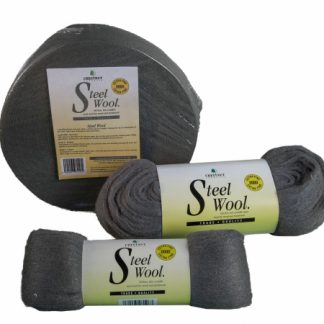 The finest of Steel Wool, very low crumble and virtually oil free to ensure there is no contamination of your work. Use it after sanding with abrasive sheets to give an ultra smooth surface, or to apply waxes to smooth the timber whilst applying a thin coat. Steel Wool burns very quickly and easily; keep it away from sources of combustion (i.e. sparks etc). Always use a knife or scissors to cut Steel Wool
The finest of Steel Wool, very low crumble and virtually oil free to ensure there is no contamination of your work. Use it after sanding with abrasive sheets to give an ultra smooth surface, or to apply waxes to smooth the timber whilst applying a thin coat. Steel Wool burns very quickly and easily; keep it away from sources of combustion (i.e. sparks etc). Always use a knife or scissors to cut Steel Wool -
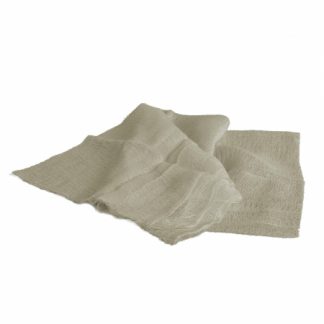 Tack Cloths are coated with a special, sticky resin. The resin doesn’t transfer off the cloth but when you wipe it across a surface it picks up and dust and removes it, leaving behind a clean surface ready for finishing. This makes it ideal for use after your final sanding to make sure that all of the sawdust generated is removed and doesn’t affect your finishing. Tack Cloths are supplied in a sealed wrapper; once opened store them in an air-tight container to prevent them from drying out. Do not use Tack Cloth with the lathe running.
Tack Cloths are coated with a special, sticky resin. The resin doesn’t transfer off the cloth but when you wipe it across a surface it picks up and dust and removes it, leaving behind a clean surface ready for finishing. This makes it ideal for use after your final sanding to make sure that all of the sawdust generated is removed and doesn’t affect your finishing. Tack Cloths are supplied in a sealed wrapper; once opened store them in an air-tight container to prevent them from drying out. Do not use Tack Cloth with the lathe running. -
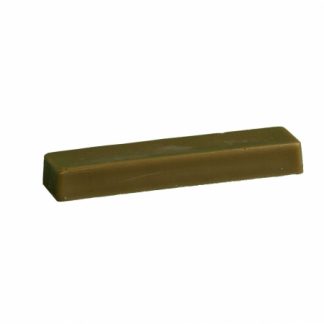 This is a solid block of carnauba wax, popular with woodturners. It gives a bright gloss finish and is also very hard wearing, able to withstand a medium amount of handling without showing finger marks. Apply over a sanding sealer by holding it against your work at it revolves on the lathe. Do not press too much – the wax is very hard and can scratch softer woods – the idea is to generate enough heat for the wax to melt slightly and transfer onto the wood. (This is easier than it sounds!). Use sparingly, and use the polishing process (using safety cloth) to ensure the wax is spread evenly. Buffing will produce a high gloss finish.
This is a solid block of carnauba wax, popular with woodturners. It gives a bright gloss finish and is also very hard wearing, able to withstand a medium amount of handling without showing finger marks. Apply over a sanding sealer by holding it against your work at it revolves on the lathe. Do not press too much – the wax is very hard and can scratch softer woods – the idea is to generate enough heat for the wax to melt slightly and transfer onto the wood. (This is easier than it sounds!). Use sparingly, and use the polishing process (using safety cloth) to ensure the wax is spread evenly. Buffing will produce a high gloss finish. -
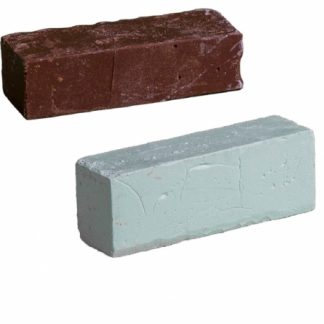 These compounds are designed to co-ordinate with the cloth used in the Buffing Wheels and Dome Buffs to give an exceptional cut and prepare the surface to a very smooth finish prior to using wax. Compound 1 -the brown one – (sometimes referred to as tripoli) is used with the ‘A’ Wheel/Dome to help smooth the applied finish. Avoid overloading the wheel/dome where possible to prevent a build up of the compound. If this happens it can be removed by either washing in soapy water or abrading the edge of the wheel with a coarse abrasive. Do not use on very open grained light coloured timber as the compound can get lodged in the grain and colour the piece. Compound 2 – the white one – (sometimes referred to as white diamond) acts as a cleanser to remove any traces of Compound 1 left on the surface (but not from the grain) and also has a very fine abrasive contained in it which smooths the work, leaving a semi-gloss finish and a superb foundation for the top coat of wax. Use Compound 2 sparingly, too much on the wheel will result in smears on the surface of your work which can be removed with buffing but this can be very time consuming and frustrating. It’s always best to apply a little and add more if needed.
These compounds are designed to co-ordinate with the cloth used in the Buffing Wheels and Dome Buffs to give an exceptional cut and prepare the surface to a very smooth finish prior to using wax. Compound 1 -the brown one – (sometimes referred to as tripoli) is used with the ‘A’ Wheel/Dome to help smooth the applied finish. Avoid overloading the wheel/dome where possible to prevent a build up of the compound. If this happens it can be removed by either washing in soapy water or abrading the edge of the wheel with a coarse abrasive. Do not use on very open grained light coloured timber as the compound can get lodged in the grain and colour the piece. Compound 2 – the white one – (sometimes referred to as white diamond) acts as a cleanser to remove any traces of Compound 1 left on the surface (but not from the grain) and also has a very fine abrasive contained in it which smooths the work, leaving a semi-gloss finish and a superb foundation for the top coat of wax. Use Compound 2 sparingly, too much on the wheel will result in smears on the surface of your work which can be removed with buffing but this can be very time consuming and frustrating. It’s always best to apply a little and add more if needed. -
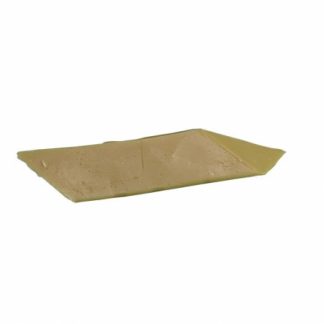 Woodturners stick wax is a mixture of beeswax and carnauba wax it is slightly softer than the Carnauba Wax Stick and therefore slightly easier to apply and there are no concerns about it marking softer woods. Applied over a sanding sealer, simply hold the stick against the revolving work and allow the heat generated to melt the wax onto the wood. Buff up straight away using Safety Cloth, using the cloth to ensure an even coating.
Woodturners stick wax is a mixture of beeswax and carnauba wax it is slightly softer than the Carnauba Wax Stick and therefore slightly easier to apply and there are no concerns about it marking softer woods. Applied over a sanding sealer, simply hold the stick against the revolving work and allow the heat generated to melt the wax onto the wood. Buff up straight away using Safety Cloth, using the cloth to ensure an even coating. -
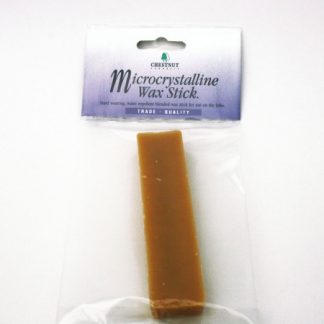
 This is the same wax Chestnut use in the tinned version of Microcrystalline Wax but in a solid block form with no solvent. This means there’s no waiting around for it to dry before buffing it.
Like the original version, this wax should be used very sparingly, a little goes a very long way and once applied it might even be necessary to spread it thinner using Safety Cloth (the texture of this makes it ideal for this purpose).
The Microcrystalline Wax Stick is also perfect for use on the Buffing Wheel System, use it on Wheel C to buff up to a brilliant, hard wearing finish.
This is the same wax Chestnut use in the tinned version of Microcrystalline Wax but in a solid block form with no solvent. This means there’s no waiting around for it to dry before buffing it.
Like the original version, this wax should be used very sparingly, a little goes a very long way and once applied it might even be necessary to spread it thinner using Safety Cloth (the texture of this makes it ideal for this purpose).
The Microcrystalline Wax Stick is also perfect for use on the Buffing Wheel System, use it on Wheel C to buff up to a brilliant, hard wearing finish. -
Out of stock
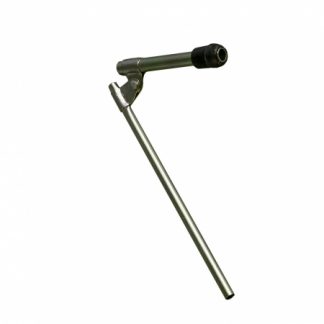 Chestnut Spray Diffusers are ideal for applying Spirit Stain; one end goes in the stain and you blow through the other end for your own mini-spray gun. Great for special decorative effects.
Chestnut Spray Diffusers are ideal for applying Spirit Stain; one end goes in the stain and you blow through the other end for your own mini-spray gun. Great for special decorative effects. -

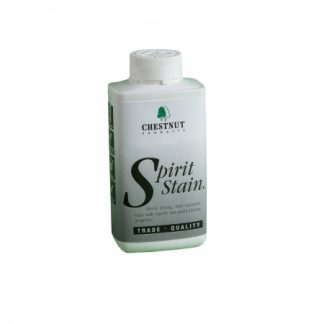 An exciting and vibrant set of colours for staining wood, Spirit Stains are methanol based to make them quick drying and because of this they also will not raise the grain of the timber they are applied to. The pigments used to make this stains are of the highest quality and all score the top ratings of 7s and 8s in the Blue Wool Scale, the measuring system used to rate fade resistance. This means you can use them with confidence knowing that the colour you apply will still be the same many years later. Spirit Stains are fully inter-mixable so you can produce virtually any colour you can think of, giving you full opportunity to be as creative as you wish. The colours will also mix after application so you can blend from one colour to another for fantastic ‘flare’ effects. Spirit Stain White is designed primarily as a mixer to create pastel shades when mixed with other Spirit Stain colours. It can be used to stain timber but as it is a translucent stain this can have a limited effect depending on the base colour of the timber used. Should you want a more subtle colour you can dilute the stains with Spirit Thinners for a delicate wash effect.
An exciting and vibrant set of colours for staining wood, Spirit Stains are methanol based to make them quick drying and because of this they also will not raise the grain of the timber they are applied to. The pigments used to make this stains are of the highest quality and all score the top ratings of 7s and 8s in the Blue Wool Scale, the measuring system used to rate fade resistance. This means you can use them with confidence knowing that the colour you apply will still be the same many years later. Spirit Stains are fully inter-mixable so you can produce virtually any colour you can think of, giving you full opportunity to be as creative as you wish. The colours will also mix after application so you can blend from one colour to another for fantastic ‘flare’ effects. Spirit Stain White is designed primarily as a mixer to create pastel shades when mixed with other Spirit Stain colours. It can be used to stain timber but as it is a translucent stain this can have a limited effect depending on the base colour of the timber used. Should you want a more subtle colour you can dilute the stains with Spirit Thinners for a delicate wash effect.
-

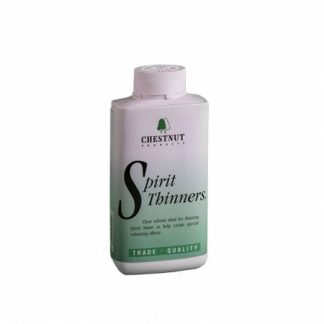 This clear, slower drying solvent is primarily for thinning our Spirit Stain to give delicate wash effects without affecting the colour (as methylated spirit would). It can also be used to dilute Friction Polish or French Polish if needed (usually only when the cap has been left off and the product has thickened up). It’s also suitable for use in making french polish if you want to dissolve shellac flakes in it.
This clear, slower drying solvent is primarily for thinning our Spirit Stain to give delicate wash effects without affecting the colour (as methylated spirit would). It can also be used to dilute Friction Polish or French Polish if needed (usually only when the cap has been left off and the product has thickened up). It’s also suitable for use in making french polish if you want to dissolve shellac flakes in it.
-

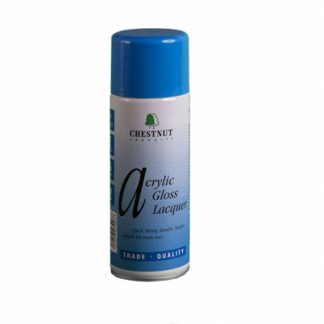
 If you don’t have access to spraying equipment, this aerosol lacquer will give you a great finish quickly and easily. A spray application is particularly relevant when trying to achieve the best gloss finish possible. Acrylic Gloss Lacquer is a high build water based lacquer specially adapted to give the best delivery through the nozzle (chosen to give excellent results without spitting, spotting or clogging in normal use) without, of course, the use of CFCs.
The lacquer itself dries quickly to give a high gloss finish straight from the can which has the benefit of being extremely hard wearing and durable – so much so that it can be used on items that will be kept outdoors or used in areas where moisture could damage other finishes.
Acrylic Gloss Lacquer is touch dry and tack free in around five minutes and hard dry in twenty minutes, ready for a second coat if needed after a light rubdown with a fine abrasive.
The sheen level can be increased if required by using Burnishing Cream (which will not affect the durability) or, after allowing 24 hours to ensure it is completely hard dry, by using it in conjunction with the Buffing Wheel Kit.
If you don’t have access to spraying equipment, this aerosol lacquer will give you a great finish quickly and easily. A spray application is particularly relevant when trying to achieve the best gloss finish possible. Acrylic Gloss Lacquer is a high build water based lacquer specially adapted to give the best delivery through the nozzle (chosen to give excellent results without spitting, spotting or clogging in normal use) without, of course, the use of CFCs.
The lacquer itself dries quickly to give a high gloss finish straight from the can which has the benefit of being extremely hard wearing and durable – so much so that it can be used on items that will be kept outdoors or used in areas where moisture could damage other finishes.
Acrylic Gloss Lacquer is touch dry and tack free in around five minutes and hard dry in twenty minutes, ready for a second coat if needed after a light rubdown with a fine abrasive.
The sheen level can be increased if required by using Burnishing Cream (which will not affect the durability) or, after allowing 24 hours to ensure it is completely hard dry, by using it in conjunction with the Buffing Wheel Kit.

-

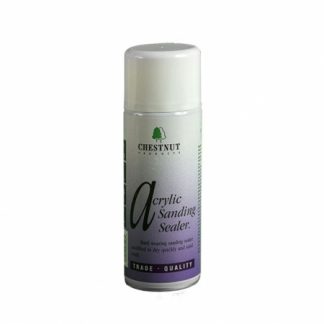
 It’s important to use a sanding sealer on most items; it gives a good foundation to your piece and can help the next coat to adhere properly to the timber.
Chestnut Acrylic Sanding Sealer does this perfectly and is designed to be used with Acrylic Gloss Lacquer, Acrylic Satin Lacquer, Ebonising Lacquer, any of their polishes and any of their waxes.
Supplied in an easy to use aerosol the dried coating complies with the EN71 Part 3 regulations governing toys and nursery furniture.
Once dried lightly sand back prior to applying your top coat.
It’s important to use a sanding sealer on most items; it gives a good foundation to your piece and can help the next coat to adhere properly to the timber.
Chestnut Acrylic Sanding Sealer does this perfectly and is designed to be used with Acrylic Gloss Lacquer, Acrylic Satin Lacquer, Ebonising Lacquer, any of their polishes and any of their waxes.
Supplied in an easy to use aerosol the dried coating complies with the EN71 Part 3 regulations governing toys and nursery furniture.
Once dried lightly sand back prior to applying your top coat.

-

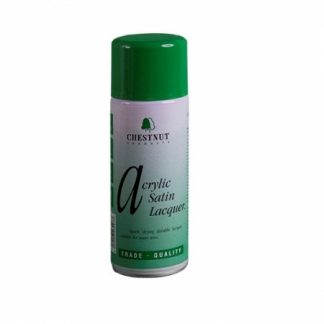
 When you need to protect your work but don’t want an overpowering shine on it, Acrylic Satin Lacquer is an ideal choice. With the benefit of an easy aerosol application, especially useful on awkward shapes, this is a hard wearing water based lacquer that will protect whatever it’s put onto, leaving an attractive satin sheen.
Acrylic Satin Lacquer is touch dry and dust free in about five minutes and hard dry about 20 minutes, ready for a second coat if needed after a light cut back with a fine abrasive.
For best results it should be used over either Cellulose Sanding Sealer or the Acrylic Sanding Sealer aerosol.
If you have a change of heart on the finish the lacquer can be brought to a gloss by using either Burnishing Cream or the Buffing Wheel Kit. Or you can simply apply a coat of Acrylic Gloss Lacquer!
When you need to protect your work but don’t want an overpowering shine on it, Acrylic Satin Lacquer is an ideal choice. With the benefit of an easy aerosol application, especially useful on awkward shapes, this is a hard wearing water based lacquer that will protect whatever it’s put onto, leaving an attractive satin sheen.
Acrylic Satin Lacquer is touch dry and dust free in about five minutes and hard dry about 20 minutes, ready for a second coat if needed after a light cut back with a fine abrasive.
For best results it should be used over either Cellulose Sanding Sealer or the Acrylic Sanding Sealer aerosol.
If you have a change of heart on the finish the lacquer can be brought to a gloss by using either Burnishing Cream or the Buffing Wheel Kit. Or you can simply apply a coat of Acrylic Gloss Lacquer!

-

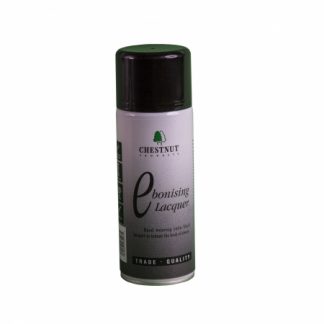
 Ebonising Lacquer is a tough, hard-wearing water-based lacquer. It is heavily pigmented so that when it is dry it emulates the classic satin look of ebony.
Usually applied over a sanding sealer (either Cellulose Sanding Sealer or Acrylic Sanding Sealer aerosol) it is touch dry in about five minutes and hard dry after twenty minutes.
Although heavily pigmented it is not paint and will still allow the grain of the timber to show through, rather than obliterating it completely.
Liming Wax and Gilt Cream can be applied over Ebonising Lacquer to give a pleasing, eye-catching yet very simple artistic effect.
If a bright gloss finish is required from Ebonising Lacquer this is best achieved by using Burnishing Cream on the lacquer with will polish it up to a high gloss.
Acrylic Gloss Lacquer can also be applied on top of Ebonising Lacquer, as can WoodWax 22 and Microcrystalline Wax.
Ebonising Lacquer is a tough, hard-wearing water-based lacquer. It is heavily pigmented so that when it is dry it emulates the classic satin look of ebony.
Usually applied over a sanding sealer (either Cellulose Sanding Sealer or Acrylic Sanding Sealer aerosol) it is touch dry in about five minutes and hard dry after twenty minutes.
Although heavily pigmented it is not paint and will still allow the grain of the timber to show through, rather than obliterating it completely.
Liming Wax and Gilt Cream can be applied over Ebonising Lacquer to give a pleasing, eye-catching yet very simple artistic effect.
If a bright gloss finish is required from Ebonising Lacquer this is best achieved by using Burnishing Cream on the lacquer with will polish it up to a high gloss.
Acrylic Gloss Lacquer can also be applied on top of Ebonising Lacquer, as can WoodWax 22 and Microcrystalline Wax.

-
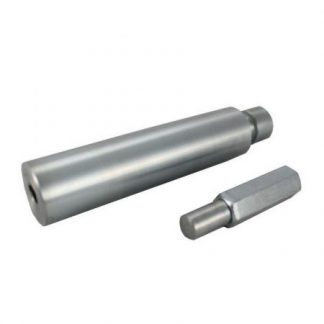 These Mandrels are available separately or come as part of the buffing wheel kit. Both Mandrels are made in the UK and are zinc plated for maximum protection. Due to the limitations of plating a blind hole care should be taken to ensure the tapped thread of the large mandrel stays as dry as possible. The large mandrel is designed to be held in a lathe chuck. It is 25mm in diameter at its widest part, stepped to 18mm with an undercut for smaller chucks. It can be held on either, both will still give plenty of clearance from the chuck. The small mandrel is designed to be held in a jacobs chuck or similar and is especially suited to use with the smaller 4 inch wheels and the Dome Buffs.
These Mandrels are available separately or come as part of the buffing wheel kit. Both Mandrels are made in the UK and are zinc plated for maximum protection. Due to the limitations of plating a blind hole care should be taken to ensure the tapped thread of the large mandrel stays as dry as possible. The large mandrel is designed to be held in a lathe chuck. It is 25mm in diameter at its widest part, stepped to 18mm with an undercut for smaller chucks. It can be held on either, both will still give plenty of clearance from the chuck. The small mandrel is designed to be held in a jacobs chuck or similar and is especially suited to use with the smaller 4 inch wheels and the Dome Buffs. -
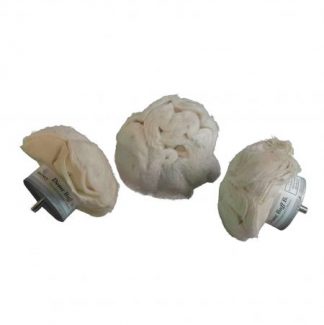 These unstitched, cotton mops are ideal for polishing the insides of bowls and boxes etc to achieve the same great finish on the inside as on the outside when using the Buffing Wheel kit, without the fear of the item being snatched from your hands by the larger Buffing Wheels. All of the domes share the same thread as in the large mandrel and the small mandrel so all parts are completely interchangeable. Due to the smaller size of these dome buffs they will require more time and sometimes more speed on the lathe to be able to match the finish given by the larger wheels. Dome Buff A is used with compound 1 to cut back the applied finish and remove any minor blemishes left behind by sanding. Dome Buff B is used with Compound 2 to cleanse the piece and also to prepare for the final polish coat by giving an exceptionally smooth surface. Dome Buff C is used with either the Carnauba wax stick, microcrystalline wax or Microcrystalline Wax Stick to give a wonderful, long lasting shine.
These unstitched, cotton mops are ideal for polishing the insides of bowls and boxes etc to achieve the same great finish on the inside as on the outside when using the Buffing Wheel kit, without the fear of the item being snatched from your hands by the larger Buffing Wheels. All of the domes share the same thread as in the large mandrel and the small mandrel so all parts are completely interchangeable. Due to the smaller size of these dome buffs they will require more time and sometimes more speed on the lathe to be able to match the finish given by the larger wheels. Dome Buff A is used with compound 1 to cut back the applied finish and remove any minor blemishes left behind by sanding. Dome Buff B is used with Compound 2 to cleanse the piece and also to prepare for the final polish coat by giving an exceptionally smooth surface. Dome Buff C is used with either the Carnauba wax stick, microcrystalline wax or Microcrystalline Wax Stick to give a wonderful, long lasting shine. -
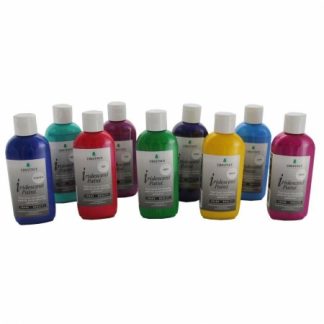 Iridescent Paints give a change in hue, a slight colour shift when viewed from different angles and are especially effective on irregularly shaped items.Available in nine different amazingly bright and vibrant colours –
Iridescent Paints give a change in hue, a slight colour shift when viewed from different angles and are especially effective on irregularly shaped items.Available in nine different amazingly bright and vibrant colours –- Green
- Azure
- Purple
- Red
- Turquoise
- Cerise
- Pink
- Yellow
- Vivid Blue
The paints are water based acrylics and can be applied by brush, cloth, spray gun/airbrush or any manner of ways to give interesting decorative effects. -
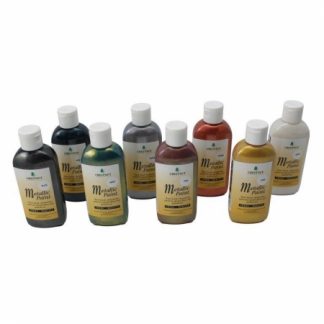 This exciting range of water-based acrylic paints comes in 8 metallic colours. Designed to add an even shimmer to your work they will really make it glow. Mix and match them, use them to highlight certain areas or cover everything in them, the choice is yours. Best used over sanding sealers, apply a spray lacquer over them once dry to seal them in. Can be applied by cloth, brush, spray gun, air brush or any suitable medium you choose!
This exciting range of water-based acrylic paints comes in 8 metallic colours. Designed to add an even shimmer to your work they will really make it glow. Mix and match them, use them to highlight certain areas or cover everything in them, the choice is yours. Best used over sanding sealers, apply a spray lacquer over them once dry to seal them in. Can be applied by cloth, brush, spray gun, air brush or any suitable medium you choose! -

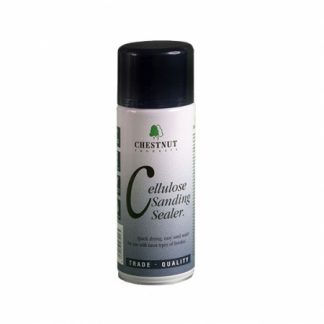
 Getting a good base for your finishing is essential when you want to get a great finish. Sometimes the piece you’re working on makes that more difficult due to its shape or size or for many other reasons.
Or sometimes you just want a quicker, cleaner method of applying a sealer.
That’s where Cellulose Sanding Sealer in an aerosol comes into its own. Basically the same product as in the tin, it has all the same benefits of quick drying and universal compatibility, it also has the added advantage of being easier both to apply and to get an even coating.
Use it before applying waxes, lacquers and polishes for a more durable final finish.
Getting a good base for your finishing is essential when you want to get a great finish. Sometimes the piece you’re working on makes that more difficult due to its shape or size or for many other reasons.
Or sometimes you just want a quicker, cleaner method of applying a sealer.
That’s where Cellulose Sanding Sealer in an aerosol comes into its own. Basically the same product as in the tin, it has all the same benefits of quick drying and universal compatibility, it also has the added advantage of being easier both to apply and to get an even coating.
Use it before applying waxes, lacquers and polishes for a more durable final finish.

-

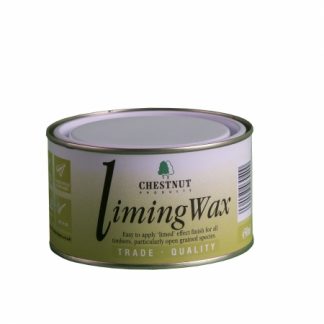 The white pigment in Liming Wax is Titanium Dioxide (TiO2) which gives it a brilliant white finish which will perfectly highlight open grain. Use Liming Wax on any open grained timber for a dramatic and striking effect which can be emphasised by using a stain or Ebonising Lacquer first. For an even better result use the Liming Brush first to open up the grain, allowing more Liming Wax to enter; spread the Liming Wax over the whole surface and then wipe off after a few minutes. The Liming Wax will stay in the open grain and the effect will be instantly visible. Whilst Liming Wax is a wax (obviously!), the wax is mainly a carrier for the white pigment. Therefore an overcoat of some kind is needed. WoodWax 22, Microcrystalline Wax, Finishing Oil or Hard Wax Oil are ideal for this and will lock the wax in place whilst keeping it clean and bright.
The white pigment in Liming Wax is Titanium Dioxide (TiO2) which gives it a brilliant white finish which will perfectly highlight open grain. Use Liming Wax on any open grained timber for a dramatic and striking effect which can be emphasised by using a stain or Ebonising Lacquer first. For an even better result use the Liming Brush first to open up the grain, allowing more Liming Wax to enter; spread the Liming Wax over the whole surface and then wipe off after a few minutes. The Liming Wax will stay in the open grain and the effect will be instantly visible. Whilst Liming Wax is a wax (obviously!), the wax is mainly a carrier for the white pigment. Therefore an overcoat of some kind is needed. WoodWax 22, Microcrystalline Wax, Finishing Oil or Hard Wax Oil are ideal for this and will lock the wax in place whilst keeping it clean and bright.
-

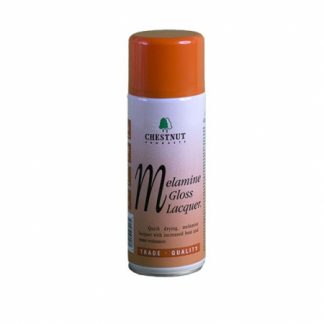
 Melamine Lacquer can be a bit fiddly to apply and there’s no better way than spraying it. If you don’t have access to spray equipment then this aerosol version is the ideal way.
Melamine Gloss Lacquer will quickly build to a bright gloss finish and dries in a matter of minutes.
Touch dry and safe to handle within five minutes the lacquer chemically cures to give a tougher finish. The lacquer achieves practically all of this (about 90%) within seven days, after which the process slows and can take up to another two weeks to fully complete.
Best used over a Cellulose Sanding Sealer (brushing or aerosol) and can be overcoated with a wax for a softer tactile feel.
Melamine Lacquer can be a bit fiddly to apply and there’s no better way than spraying it. If you don’t have access to spray equipment then this aerosol version is the ideal way.
Melamine Gloss Lacquer will quickly build to a bright gloss finish and dries in a matter of minutes.
Touch dry and safe to handle within five minutes the lacquer chemically cures to give a tougher finish. The lacquer achieves practically all of this (about 90%) within seven days, after which the process slows and can take up to another two weeks to fully complete.
Best used over a Cellulose Sanding Sealer (brushing or aerosol) and can be overcoated with a wax for a softer tactile feel.

-

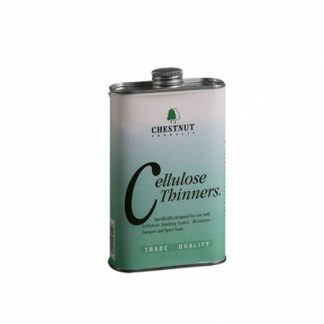 This pure cellulose solvent is a high quality dilutant for our cellulose based products, such as Cellulose Sanding Sealer and Melamine Lacquer. Thinning these products can help to make them easier to apply, especially over larger areas as it helps them flow out. Cellulose Thinners is also useful for cleaning any spills you may have in the workshop and is strong enough to help clean most things, taking care to ensure that it does not attack It can also be used to thin Spirit Stain to give a delicate wash effects, although spirit thinners is the better option for this.
This pure cellulose solvent is a high quality dilutant for our cellulose based products, such as Cellulose Sanding Sealer and Melamine Lacquer. Thinning these products can help to make them easier to apply, especially over larger areas as it helps them flow out. Cellulose Thinners is also useful for cleaning any spills you may have in the workshop and is strong enough to help clean most things, taking care to ensure that it does not attack It can also be used to thin Spirit Stain to give a delicate wash effects, although spirit thinners is the better option for this.
-
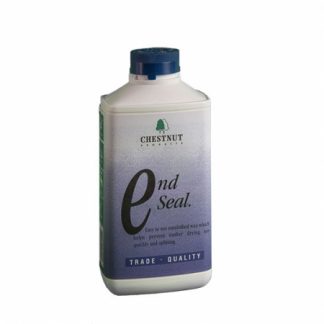 End Seal is an emulsified paraffin wax used the seal the ends of freshly cut timber to slow down the drying process and reduce the risk of the timber splitting. It can also be used on work-in-progress that is being left unfinished where there is a risk of the timber splitting. Apply it liberally, normally by brush but it can be sprayed if needed, usually to the smallest surface of the timber which will normally be the end grain where moisture is most likely to escape from. Sealing the surface will encourage the moisture to escape via the larger areas which will result in a slower exit.
End Seal is an emulsified paraffin wax used the seal the ends of freshly cut timber to slow down the drying process and reduce the risk of the timber splitting. It can also be used on work-in-progress that is being left unfinished where there is a risk of the timber splitting. Apply it liberally, normally by brush but it can be sprayed if needed, usually to the smallest surface of the timber which will normally be the end grain where moisture is most likely to escape from. Sealing the surface will encourage the moisture to escape via the larger areas which will result in a slower exit. -

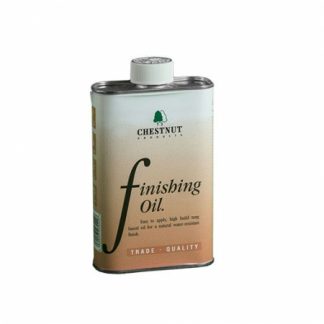
 Chestnut Finishing Oil is Chestnuts' version of Danish Oil* and uses Tung Oil as its base but with the addition of solvents and driers. This aids the drying of the product and speeds it up dramatically, so that it’s dry within eight hours. It has a pale amber colour and dries to a hard yet flexible film which is very hardwearing and water resistant.
For a high gloss finish apply several coats with a light rub down between coats; after 5 or 6 coats a good sheen should be visible.
Finishing Oil is normally applied by cloth but on larger areas a brush can be used very successfully.
Chestnut Finishing Oil is Chestnuts' version of Danish Oil* and uses Tung Oil as its base but with the addition of solvents and driers. This aids the drying of the product and speeds it up dramatically, so that it’s dry within eight hours. It has a pale amber colour and dries to a hard yet flexible film which is very hardwearing and water resistant.
For a high gloss finish apply several coats with a light rub down between coats; after 5 or 6 coats a good sheen should be visible.
Finishing Oil is normally applied by cloth but on larger areas a brush can be used very successfully.

-

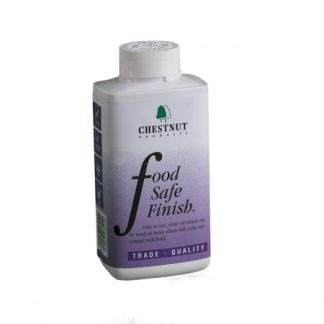 Food Safe Finish is a clear, food grade mineral oil. Chestnut use a thin grade of oil to allow it to soak into bare timber which then protects it against water splashes etc whilst not tainting or affecting the food in any way. It dries to a fairly matt finish; it is however ideal to use for wet sanding and when used with a very fine abrasive it can give an exceptionally smooth surface which has its own gentle glow. Apply with a clean cloth or brush direct onto bare wood, up to three coats are recommended. If the oil sits on the surface and won’t soak in it means the timber has absorbed as much as it can and no further coats are needed. Any surplus can be removed with a clean cloth if required. Depending on the way the item is used it might be necessary to top-up the finish, especially if it is washed regularly.
Food Safe Finish is a clear, food grade mineral oil. Chestnut use a thin grade of oil to allow it to soak into bare timber which then protects it against water splashes etc whilst not tainting or affecting the food in any way. It dries to a fairly matt finish; it is however ideal to use for wet sanding and when used with a very fine abrasive it can give an exceptionally smooth surface which has its own gentle glow. Apply with a clean cloth or brush direct onto bare wood, up to three coats are recommended. If the oil sits on the surface and won’t soak in it means the timber has absorbed as much as it can and no further coats are needed. Any surplus can be removed with a clean cloth if required. Depending on the way the item is used it might be necessary to top-up the finish, especially if it is washed regularly.

